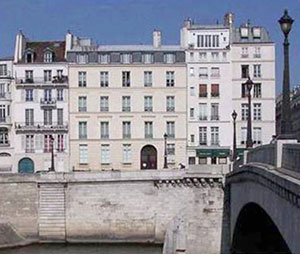The Polish Library in Paris

The Polish Library in Paris, which was established in 1838 by members of the Great Emigration, was opened in 1839. Since 1854, it has been located in the building at 6, Quai d’Orléans. Based on an agreement concluded in 1893 between the Historical and Literary Society of Paris and the Academy of Arts and Sciences, ownership of the library passed to the latter institution, which took over the building and collections. At the same time, it established an Arts and Science Base operating from the library. From natural causes, as it were, the activities of the Historical and Literary Society of Paris then ceased entirely. The following, in chronological order of their involvement, played a major role in the history of the library: Prince Adam Jerzy Czartoryski, his son, Prince Władysław Czartoryski, Władysław Mickiewicz (son of Adam), and Franciszek Pułaski.
The Polish Academy of Science, which was formed in 1951, took over the assets and property of PAU, while also claiming the right to the Polish Library in Paris. Court hearings began, which eventually culminated in the judgement of the Court of Appeal of the City of Paris of 8 July 1959, which did not recognise PAN as the successor of PAU. The library's building and collections were taken over by the French treasury and leased to the Historical and Literary Society of Paris, which had been revived in 1946. The library’s financial supporters have included the Alfred Jurzykowski Foundation, the Polish American Congress, the Barbara Piasecka-Johnson Foundation, the De Brzezie Lanckoroński Foundation, the Zygmunt Zaleski Foundation, and a number of private individuals.
The library building was thoroughly renovated in 2000–2004 on the initiative of the president of the Historical and Literary Society of Paris, Kazimierz Piotr Zaleski. Its ceremonial reopening in 2004 heralded a new era for the Polish Library in Paris – including in its relationships with the Historical and Literary Society of Paris and PAU. PAU assumed the obligation to share in financing the library, which was achieved using funds allocated by the Ministry of Education and Science. PAU has also supported the library’s everyday work: in 2004–2011 by sending highly qualified subject-matter experts, and now by applying for and carrying out research projects aimed at inventorying, cataloguing, processing, and digitalising its collections. List of Projects: http://pau.krakow.pl/index.php/pl/dzialalnosc/projekty-badawcze
The special collections of the Polish Library in Paris (collections of paintings, sculptures, drawings, prints, and photographs) are available on the PAUart site: http://www.pauart.pl/app/browse?q=~(facets~(folders~(~%27biblioteka_w_paryzu)))%20.
In 2014, under the leadership of the Ministry of Culture and National heritage, PAU and the Historical and Literary Society of Paris worked to open a new institution, which would take over the funding of the Polish Library in Paris and be known as, Instytut Biblioteka Polska w Paryżu [Polish Library Institute in Paris]. The Institute was established on 9 October, 2023. Work is now underway on the formal handover of the building, equipment and collections.
The library's collection began with the family heirlooms of refugees, books from private collections saved through the years of war and wandering, and documents relating to the events of the times.The extensive collections range from the first half of the fifteenth century to the present day. The library stores valuable old prints as well as prints and documents relating to the Polish national uprisings of the nineteenth century and to the activities of émigré institutions, organisations and societies. It also keeps Polish periodicals relating to the emigration. Part of the collection is the legacy of Adam Mickiewicz – as donated by his son, Władysław. The collection also contains memorabilia of Frédéric Chopin. The Polish Library in Paris also keeps collections of art, including paintings, watercolours, and prints by Teofil Kwiatkowski, Olga Boznańska, Leon Wyczółkowski, Józef Czapski, Jan Piotr Norblin, Romeyn de Hooghe, Honoré Daumier, Eugène Delacroix, and Horace Vernet, and sculptures by Bolesław Biegas, Xawery Dunikowski, and Edward Wittig. Many of its holdings were donated to the library from the legacies and collections of émigrés and émigré institutions. In addition to collecting materials on Polish history, culture, art, and literature (including the history of literature), and on the history of Polish exile and emigration, the Polish Library in Paris also documents the contemporary life of Poles outside their homeland, the way they function in the political and social contexts of their countries of residence, Polish-French relations, and Poland’s presence in a united Europe.
The library offers a rich resource for investigations of the history of the Great Emigration and later waves of emigration and into the history of Polish literature, art, and culture in the nineteenth and twentieth centuries.
The website of the Polish Library Institute in Paris - https://ibpp.eu/



